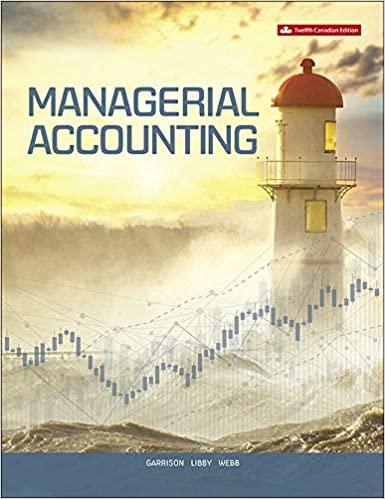Answered step by step
Verified Expert Solution
Question
1 Approved Answer
I need a d aomplete accounting simulation. I need a sales budget, a production budget, a raw material budget, and a manufacturing overhead budget (
I need a d aomplete accounting simulation. I need a sales budget, a production budget, a raw material budget, and a manufacturing overhead budget including indirect labor wages & benefits, depreciation, property tax for the production facility, and other indirect expenses
At the beginning:
ASSETS
Current Assets:
Cash: $
Accounts Receivable: $
Prepaid Taxes:
Prepaid Expenses:
Raw Material Stocks: $
Finished Product Stocks: $
Temporary Difference on Deferred Tax Assets:
Fixed Assets:
Costs: $
Accumulated Depreciation: $
Total Assets: $
LIABILITIES
Current Liabilities:
Bank Loan: $
Accounts Payable: $
Lease Obligations:
Taxes Payable:
Longterm Liabilities:
Longterm Debts: $
Total Liabilities: $
SHAREHOLDERS' EQUITY
Share Capital: $
Retained Earnings: $
Total Equity: $
Total Liabilities and Equity: $
There are months in a quarter.
There are quarters in a year.
There are months in a year.
Quarterly sales in jars for quarter of year t: $
Quarterly sales in jars for quarter of year t: $
Expected selling price in the last quarter of year t: $
Every year, the company makes a significant portion of its sales approaching the holiday season. Sales remain stable for all other quarters except the fourth quarter. The growth in quantities sold for quarter is approximately
Competition is fierce in the food industry, which is why the company plans slight price increases for the next fiscal years. Here are the price increases relative to the previous quarter:
st quarter year t:
nd quarter year t:
rd quarter year t:
th quarter year t:
st quarter year t:
nd quarter year t:
To encourage prompt payment from customers, BONNE CONFITURE! offers the following credit terms to its customers: net
Accounts receivable collection period:
Within days of invoicing:
During the quarter but more than days after invoicing:
The following quarter:
The second quarter following:
Beginning accounts receivable includes a portion of sales from Q and Q of year t Here are the percentages of accounts receivable that will be collected in Q and Q of year t related to sales in Q and Q of year t:
Percentage of accounts receivable collected in Q year t:
Percentage of accounts receivable collected in Q year t:
Stock management:
There is no inventory of work in progress at the beginning or end.
Sales in the last quarter are always much higher due to the holiday season. The company increases its jam jar stocks according to this increased demand. Here are the jam jar requirements as a percentage of forecasted sales in jars for the following quarter:
st quarter:
nd quarter:
rd quarter:
th quarter:
The unit cost $ CAD of jam jar stock at the beginning is $
Attention: Use the cost of sales for each quarter and not the annual average to value finished goods inventory.
The company uses rational costing. The basis for allocating manufacturing overhead costs is the number of jam jars.
Raw material inventory at the end corresponds to a percentage of raw material requirements for production in the following quarter:
Production Information:
Purchase price $ USD ml for raw materials in inventory in the last quarter of year t: Price: $ USD, Quantity: ml
Raw material prices vary widely based on market index. Here are the estimated prices for year t$ USD ml:
st quarter: $ USD ml
nd quarter: $ USD ml
rd quarter: $ USD ml
th quarter: $ USD ml
Quantity ml of raw materials expected per jam jar: ml
Purchasing policy for raw materials:
During the quarter:
The following quarter:
The company incurs several costs to support production. These costs are allocated by quarter based on units produced. Note that these costs are disbursed at the same rate as their allocation, except for property taxes.
Annual utility cost: $
Annual maintenance and repair cost: $
Annual property tax for the production facility: $
Property taxes must be paid in full in the first quarter.
Salary Information:
The manufacturing process being highly automated, there is no direct labor.
The table below includes the information needed to calculate the payroll:
Production Manager: $
Laboratory Technicians and Quality Control: $
Process Engineers: $
Administrative Managers: $
Sales Director: $
All employees will receive a bonus on December of year t based on budget attainment. The bonus amount per employee is $ In past years, the required performance target has always been met.
The value of the company's benefits equals a certain percentage of the payroll, excluding bonuses. This percentage is This amount is paid on payday.
Assets:
Cash: $
Step by Step Solution
There are 3 Steps involved in it
Step: 1

Get Instant Access to Expert-Tailored Solutions
See step-by-step solutions with expert insights and AI powered tools for academic success
Step: 2

Step: 3

Ace Your Homework with AI
Get the answers you need in no time with our AI-driven, step-by-step assistance
Get Started


